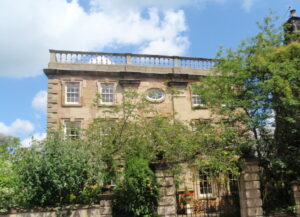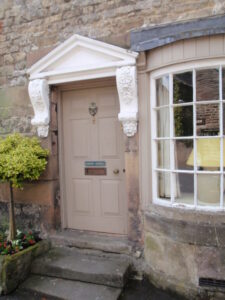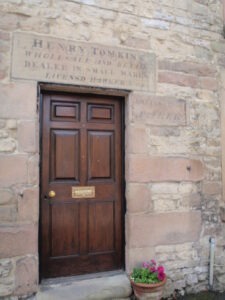WINSTER
Earliest recorded settlement in the Winster area is from two thousand years ago in the Iron Age. Two pieces of Anglo Saxon jewellery including a richly carved cross of pure gold, surmounted by a cut garnet were dug up when Winster Moor was enclosed in 1765-6.
The name ‘Winster’ is first recorded in Domesday Book (1086) as Winsterne, deriving from the name “Wine’s thryne” (thorn bushes), presumably after a local landmark, and had about twenty dwellings.
A Norman chapel was built on the site of the present church in the late 11th century. St Johns Parish Church sits at the foot of West Bank, with its squat grey tower hidden from view at the end of Main Street by the Dower House. The tower was added in 1721 and the church was extensively rebuilt and enlarged twice during the 19th century.
Five centuries later, Winster was still a one street village but by then it had its own market, under the arches of the 16th century Market Hall. Late 17th or early 18th century market house. The upper part of the Market Hall is brick built, but was probably originally timber framed. The arches were originally open and used by miners and street traders, whilst dairy produce was sold in the upper storey.
The upper part of the Market Hall is brick built, but was probably originally timber framed. The arches were originally open and used by miners and street traders, whilst dairy produce was sold in the upper storey.
In 1906 Winster Market House became the first Derbyshire property to be acquired by the National Trust, at a cost of £50 and is now a listed building.
It is an Information room with interpretation panels and a scale model of Winster village.
By the late 16th century there was still no inn at Winster and lead mining appears to have been carried out on a family business scale. It was not until the 1700’s that Winster grew into a market-town and trebled its population. By 1676 Winster’s population was around 600. Most lived in the area around the Market Hall although a small settlement called Islington Green, thought to be miners, once stood astride Islington Lane behind the Miners Standard and close by the Ore House. Islington is shown on Burdett’s Map of Derbyshire 1791.
Now a field lane this was an important route in Anglo-Saxon times as it is a portion of The Portway which crossed the county from the south east to the north west. The village had gone by the start of the 19th century.
By the mid-18th century, at the height of its mining boom, Winster may have been the fourth largest town in the county, with a population of 1,563 in 1761. In 1751 it could have been even larger for it then had 24 inns and alehouses as against 18 a decade earlier.
Mining brought immense prosperity. Between 1720 and 1770, Winster’s population had grown to more than 2,000 and over 20 inns had sprung up. Most of the houses, now standing in Winster, date from those times. But the huge amounts of ore extracted eventually rebounded on profitability. By the late 18th century, the London Lead Company found their Derbyshire operations too costly and sold their Peak District concessions in 1778.
By the end of the 18th century, most of the mines had closed, with only two continuing to operate into the 19th century. Population returns dramatically reflect the industrial decline. In 1789 the population had declined to little more than 1000 and by 1801 there were only 750 people in the village.
 A boom carried the population back over the 1000 mark in 1841, when the village supported five or six pubs.
A boom carried the population back over the 1000 mark in 1841, when the village supported five or six pubs.
Beer was then believed to be a cure for lead-poisoning. An inn which has survived since the 17th century is The Miner’s Standard which was built in 1653, is outside the main village, by the road which leads to Grangemill and Newhaven. It was once surrounded by a miners’ shanty-town.
In the mid 19th century beer was believed to be a cure for lead-poisoning. There were around 18 pubs in the mid 18th century but one inn which has survived since the 17th century, is The Miner’s Standard built in 1653. It is outside the main village, by the road which leads to Grangemill and Newhaven and was once surrounded by a miners’ shanty-town.
Most miners lived in the area around the Market Hall although a small settlement called Islington Green, thought to be miners, once stood astride Islington Lane behind the Miners Standard and close by the Ore House.
The water supply was Winster mere.
Mosey Mere was once the water supply to Islington village which once stood near these crossroads and behind The Miner’s Standard, but this small mining village has long since completely disappeared.
This mere is said to hold its water due to being built on a thin bed of volcanic lava however mere builders generally worked to traditional skills. They would first excavate a circular hollow with sloping sides that would make the water easily accessible to cattle and sheep. This was then lined with several inches of slaked lime to form an impermeable layer. Next prepared clay was tamped against the base and sides of the hollow by working upwards to ground level. The clay was covered with a layer of gravel or ashes and pitched with stone and finally the rim was strengthened with stone and gravel.
There is a misconception about so-called ‘dew ponds’ in that they are not topped up by morning dew but take their name from an 18th century maker named Dew.
On the East side of the Winster to Grangemill road adjacent to the Limestone Way and opposite the Ore House, there is a narrow field with an old building on it. It is documented as being the site of a rope walk. With so much lead mining in the area it would have been a very lucrative business and right on the doorstep.
In more recent times, Winster men worked at the Mill Close Mine, near Stanton-in-Peak, the richest mine in Britain by 1931, when it raised 26,000 out of the 29,000 tons for the whole of Britain. Electric pumping prolonged its life. But disastrous flooding, in February, 1938, when it took a month to gain control, brought operations to an end. The shot, fired by Fred Boam of Winster, had tapped the Pilhough Fault.
Generally, the road to affluence and social position was marked by the purchase of land and property and in the early 19th century, the Brittlebank family followed this route. William Brittlebank resigned as solicitor (his office was at Wirksworth) for the CHPR in October 1855 and his place was taken by Philip Hubbersty and Andrew Brittlebank of Winster. The Brittlebanks were arrogant and greedy and by mid-century they owned half of the parish, though not, ironically, their own house, Oddo. Their reputation was damaged by the “murder” of the local Doctor Cuddie, by William Brittlebank, in a spuriously forced duel. Though described locally as the “Merry Monarches of Winster”, the Brittlebanks failed to gain social recognition and when they finally sold up in 1891, they had accumulated debts of £80,000, allegedly incurred at Monte Carlo! Many villagers were then able to repurchase lost by their families a half century earlier.
Winster Hall is a three-storied structure of local gritstone built on Main Street by local lead magnate Francis Moore in 1628 is on the north side of Main Street. It’s balustraded roof, Tuscan columns and Venetian windows were all added in the 18th century. Legend has it that around this time the daughter of the house fell in love with a servant, and their forbidden tryst was ended when together the lovers leapt from the parapet to their deaths. It is said that the forecourt is haunted by the ghost of a `White Lady’.
The Moore family rose from yeoman status in the 17th century to that of gentleman by about 1720, when they rebuilt the Hall. It became an inn in the 1970’s but has now reverted to being a private dwelling. The Hall is three-storeyed, with all the trappings; rusticated quoins and a cornice topped by a parapet, complete with a balustrade. The windows are sliding sashes set in stone frames, with keystones and there is a roundel in the centre front and a good doorway with columns either side, surmounted by an entablature. The Hall stands back from the main street behind a sturdy pair of gate piers. Gritstone, for the construction of the Hall was brought by pack-horses from the Stancliffe Quarries in Darley Dale. In the 19th century Winster Hall was the home of historian and antiquary Llewelyn Jewitt, owner, editor and main author of `The Reliquary’and a 19th century antiquary, whose grave can be found in the churchyard. Jewitt was a skilled engraver. He illustrated a famous book on architecture, wrote books on ceramic art, “A History of Derbyshire”, and many stories and ballads of the county. He was also a practical man and he helped to arrange a piped supply for Winster in 1871. Residents ‘helped most nobly with their labour’ to lay the three-mile pipeline. Almost £1,000 was raised and eight public taps were erected in the village.
 A wall plaque records that Bank House on West Bank, built around 1580, has traditionally been the home of the village doctor for over 100 years. It was here on May 22nd 1821 that William Brittlebank of nearby Oddo House murdered Dr.William Cuddie. A reward of £100 was offered for the capture of 27 year old Brittlebank, – who promptly did a Lord Lucan and was never seen again!
A wall plaque records that Bank House on West Bank, built around 1580, has traditionally been the home of the village doctor for over 100 years. It was here on May 22nd 1821 that William Brittlebank of nearby Oddo House murdered Dr.William Cuddie. A reward of £100 was offered for the capture of 27 year old Brittlebank, – who promptly did a Lord Lucan and was never seen again!
See Brittlebank/Cuddie duel.
A hundred and twenty years ago two Hydropathic Institutions were advertising for business at Winster: James W.Taylor of Bank House and the Heathcote Brothers of Winster Hall. Neither gave details of their water cures but emphasised the romantic scenery, invigorating climate and ‘the bracing effects of the mountain air’.
 Oddo House stands at the end of it’s curving tree-lined drive amidst landscaped parkland to the west of the church. It was first occupied by Hugh Brittlebank, a solicitor in 1700 and remained in that family for 200 years. The Brittlebank’s also owned most of the village, for when they left in 1891 they sold not only Oddo House but `3 farms, 68 lots of choice accommodation‘, and `meadow and pasture land‘ – a total of over 273 acres! A parcel of this land is now occupied by the new cemetery to the north of Oddo House, and the large Victorian Vicarage standing opposite.
Oddo House stands at the end of it’s curving tree-lined drive amidst landscaped parkland to the west of the church. It was first occupied by Hugh Brittlebank, a solicitor in 1700 and remained in that family for 200 years. The Brittlebank’s also owned most of the village, for when they left in 1891 they sold not only Oddo House but `3 farms, 68 lots of choice accommodation‘, and `meadow and pasture land‘ – a total of over 273 acres! A parcel of this land is now occupied by the new cemetery to the north of Oddo House, and the large Victorian Vicarage standing opposite.
The impressive Dower House stands back to back with the church at the western end of Main Street, and though much altered, dates from around 1600.
Winster had 3 chapels built between 1823 and 1852.
There are many interesting buildings on Main Street including Moot House – presumably connected with the lead industry and a Hawkers residence. The sign above the door reads – Henry Tomkins. Wholesail Retailer. Dealer in  Small Wares. Licensed Hawker
Small Wares. Licensed Hawker 
The Old Bakery premises at the top of Pump Lane on Main Street converted into a general store, off-licence and newsagent.



